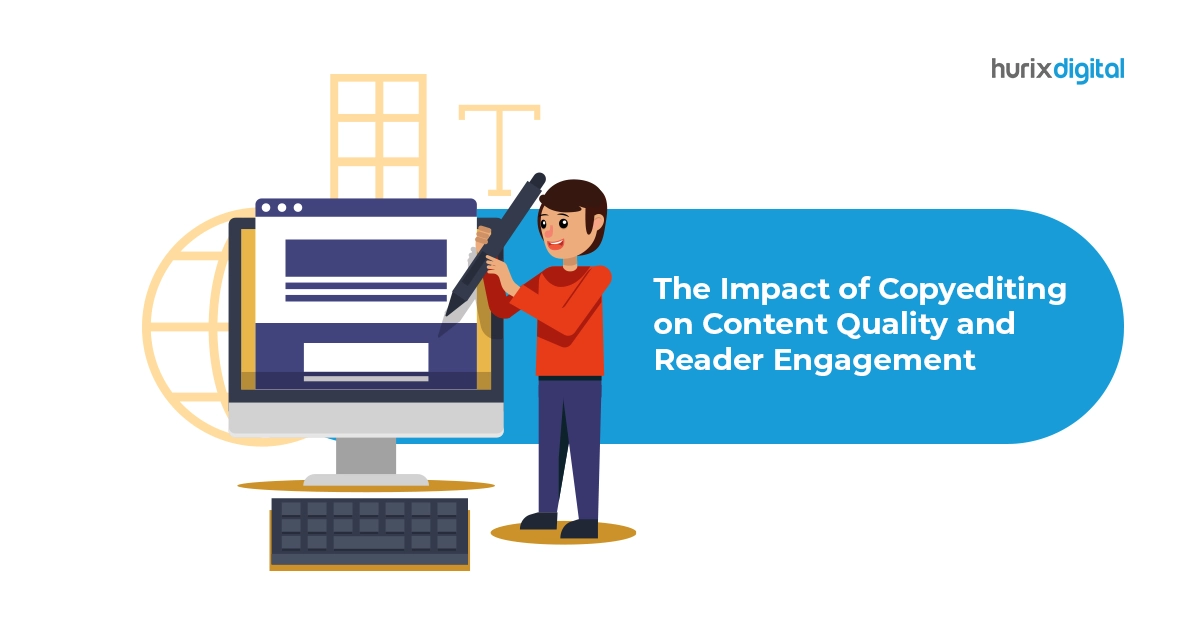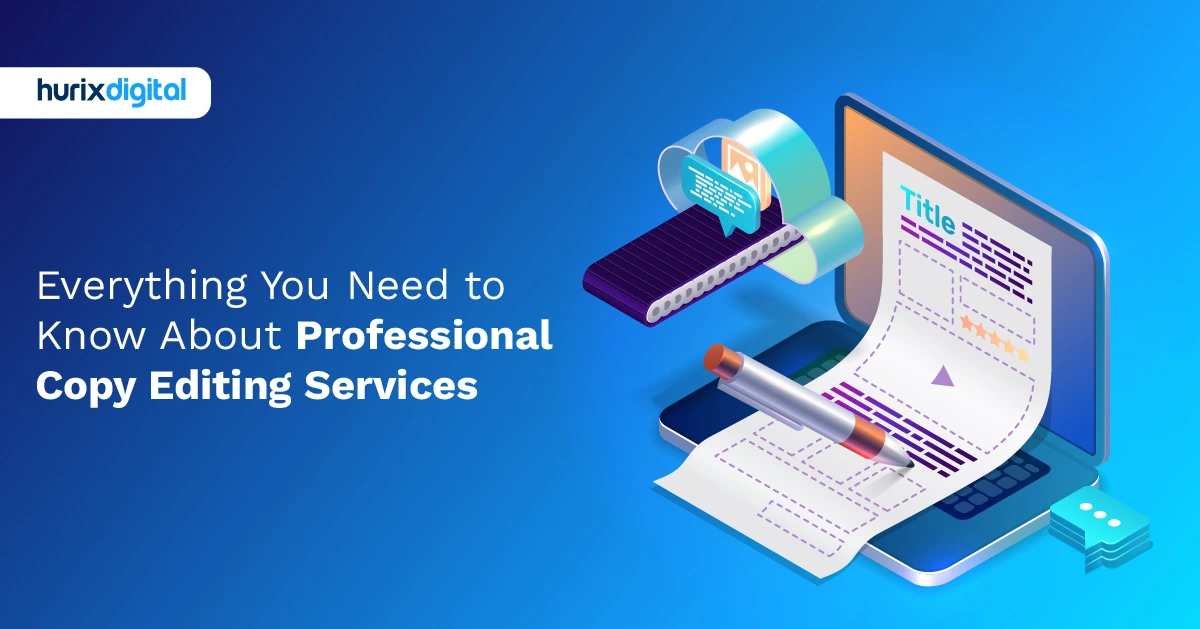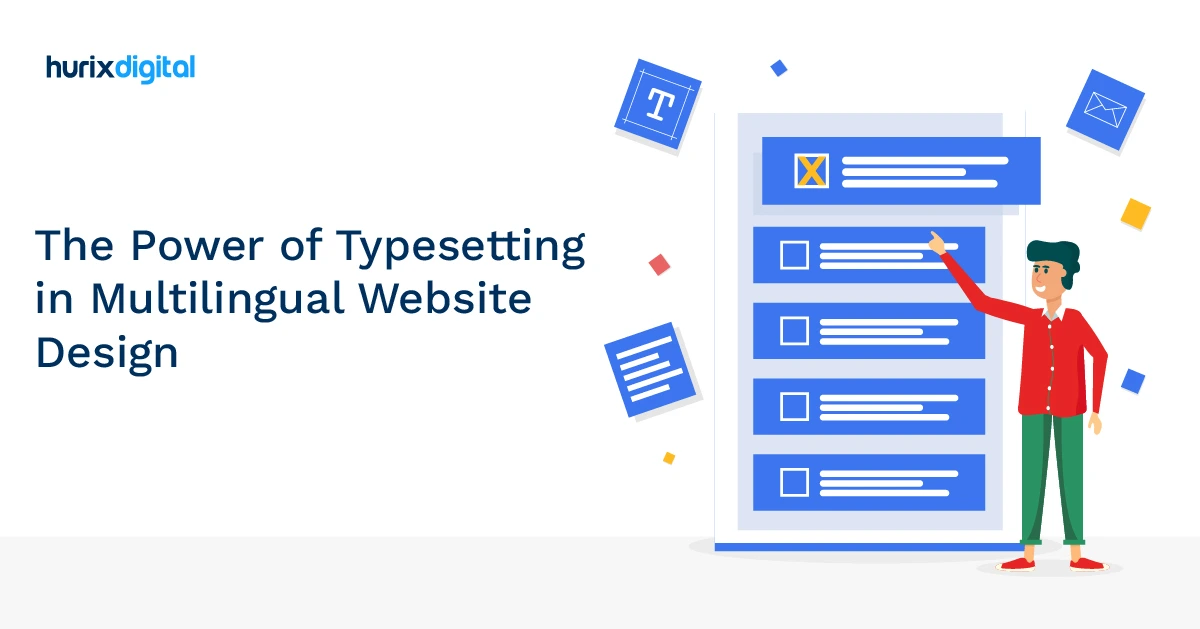
The Smart User’s Guide to Inclusive and Multilingual Copyediting
Summarize with:
This blog talks about all you need to know to copy-edit inclusive content and in multiple languages. It also points out tools and smart ways editors can use to ensure the content is easy to understand, fits the culture, and is ready for readers in any language.
The importance of copyediting in ensuring a clear, consistent, and professional writing process is immense.
However, what is even more important is to ensure diversity and inclusion in creating ethical and effective copyediting that completely resonates with your audience and helps build trust and loyalty as well.
Diversity here means recognizing and regarding the differences among people, such as their age, gender, culture, ethnicity, etc. Likewise, inclusion in copyediting means creating a sense of value and belonging for everyone, regardless of their differences.
Applying the principles of diversity and inclusion to your copyediting services allows you to cater to a wider and more diverse customer base, increasing your brand’s reputation and credibility.
To this end, this post will explore more about tools and copy editing resources to help you understand your audience, their needs, preferences, challenges, and goals to help you make your copyediting more diverse and inclusive.
Table of Contents:
- The Multiple Stages of Editing
- Copy Editing vs. Line Editing: The Differences
- Copy Editing vs. Line Editing: An Example
- What are Multilingual Copyediting Services?
- 6 Best Practices for Choosing a Copyediting Service for Multilingual Content
- What is Inclusive Copyediting?
- Ways to Research Your Audience and Their Needs
- How to Use Inclusive Language?
- Wrapping Up

The Multiple Stages of Editing
The consensus amongst professional editors is that there are primarily four well-defined stages in the editing process.
1. Developmental/Structural Editing
This is the first stage in the editing process, and the focus here primarily revolves around the flow and pace of the draft, the characters, the plot, the arrangement, the length, and the number of chapters, to name a few. The Point of View (POV) is another crucial area of focus at this stage.
2. Line Editing
Line Editing, also known as stylistic editing, comes after the developmental edit stage. This editing phase focuses on improving the language by improving the stylistic construction of sentences. Contrary to popular belief, line editing does not deal with grammar issues.
3. Copy Editing
The copyediting phase comes next, and the focus here lies on the technical aspects of writing: spelling, Grammar, and punctuation. Just as with line editing, copy editing is performed one line at a time, and herein lies the root of the confusion between the two stages (which we will discuss in depth in the coming sections).
4. Proofreading
Proofreading is considered the final stage of the editing process. It involves reading over the content to ensure everything is in order before a draft is published. This stage ensures there are no spelling errors, missed words, extra spaces, etc.

Copy Editing vs. Line Editing: The Differences
While line and copy editing share some similarities, they are two very distinct stages in the editing process, each requiring professionals with varied and distinct competencies.
Let’s dive into the intricacies of each to understand them better.
1. Line Editing
As mentioned earlier, the bedrock of line edits is to improve the text’s clarity, coherence, and flow by revising sentences, paragraphs, and transitions. Line editors also pay special attention to the tone and emotion and ensure that your writing style is consistent throughout the draft or manuscript.
A line editor will focus on and check for the following:
- Superfluous or overused words or phrases
- Correct for bland language, weak verbs, and tonal shifts
- Fix ambiguity in run-on sentences or danglers
- Improve transitions between paragraphs or scenes
- Fix narrative digressions
- Check for and correct any factual inconsistencies
2. Copy Editing
On the contrary, copy edits ensure that the draft strictly follows the rules of Grammar. Copy Editing is the final stage before a draft or a manuscript is sent over for proofreading, formatting, and, finally, publishing.
A copy editor’s job is to check for and correct the following:
- Grammar, punctuation, and spelling
- Consistency in the language used (US English vs. British English)
- Fixing any inconsistencies concerning capitalization, hyphenation, fonts, italicizing, and numerals (e.g., when to use numbers vs. text)
- Contextual inconsistencies
Copy Editing vs. Line Editing: An Example
Let’s look at an example better to understand the subtle differences between line and copy editing.
She was a briliant student, but she had a hard time making friends. She always felt like she didn’t fit in with the others, who seemed to have more fun and less worries.
A line editor would approach the text first, asking themselves the following questions.
- Is the writing clear and coherent?
- Is it conveying the intended message, tone, and voice?
- Is the writing engaging and interesting enough for the reader?
- Are there any redundancies, vagueness, and clichés?
Based on the above questions, they would make the following changes.
- “She was a briliant student” could be changed to “as a briliant student” to create a contrast between her academic ability and her social skills.
- “Had a hard time” could be changed to “struggled” to use a stronger verb.
- “Didn’t fit in with” would be changed to “felt alienated from” to convey emotion better.
- “The others” would be changed to “her peers” to use a more precise and relevant word identifying her group.
- The section “have more fun and fewer worries” would read better when changed to “enjoy life more and worry less” to use parallelism and avoid repetition.
The edited sentence should now read:
As a briliant student she struggled to make friends. She felt alienated from her peers, who seemed to enjoy life more and worry less.
A copy editor would look at these sentences next and try to correct any errors or inconsistencies in the writing. They would approach each sentence with the following questions in mind.
- Is the writing grammatically correct? Is it free of spelling or punctuation mistakes?
- Is the writing accurate and consistent with facts and details?
- Is the writing formatted properly and adhering to a specific style guide?
A copy editor would make the following changes to the above text.
As a brilliant student, she struggled to make friends. She felt alienated from her peers, who seemed to enjoy life more and worry less.
Here are some of the changes that the copy editor made and why:
- They added a comma after “student” to separate the two independent clauses.
- They corrected the spelling of “briliant” to “brilliant.”
Remember that these changes are not set in stone and may vary based on several parameters.
What are Multilingual Copyediting Services?
Multilingual copyediting services are specialized services that can help your company or business create comprehensive branding across different markets and languages.
This, in turn, ensures that your organization’s values are rightly adapted for the target audience. Put simply, multilingual proofreading and copyediting services emphasize creating engaging content in the native language of a target market while keeping the company’s core values in mind.
Likewise, these services also consider various factors that drive consumer behavior, thus ensuring that the content created is suitable and engaging for your chosen audience.

6 Best Practices for Choosing a Copyediting Service for Multilingual Content
Multilingual copyediting is quite a complex process that requires a set of very specific skills. In this section, we will explore six best practices for choosing a copyediting service for such multilingual content:
1. Thoroughly Assess Your Needs
One of the most important factors to consider when choosing a copyediting service for multilingual content is thoroughly assessing your needs. Start by thinking about what you hope to achieve with copyediting.
Having clarity and understanding of your goals for a specific multilingual piece of content will help you choose the best and most appropriate service provider for your unique needs.
This also means that you can look for a copyediting service specializing in the level of edit you need. For instance, developmental copyediting services have a different focus from line editing. Knowing precisely what you require will help you find the right copyediting service for your particular manuscript.
2. Expertise in Languages
Another important step here is to decide which languages you wish to use for your multilingual content based on factors such as your goals, target audience, overall budget, and resources, and accordingly, choose the copyediting service provider.
You can either focus on a selected few key languages that are highly demanded and have potential for your business or cover as many languages as possible to reach a wider audience.
Another important thing that you need to consider here is the availability and quality of editors, translators, and proofreaders for each language that you have selected. Make sure to inform your copyediting service provider of the specific style of English you intend to use that allows them to concentrate on the more relevant things within your content copy of the manuscript, thus ensuring higher quality edits in a shorter time frame.
3. Optimize for SEO
When it comes to multilingual content development, one of the key challenges is optimizing your content for top search engines and increasing your visibility and ranking.
Start by conducting keyword research for each selected language and market. Then, use the relevant keywords in your titles, meta tags, headings, and body text accordingly. Additionally, it is very important to monitor and analyze your SEO performance and make any necessary adjustments.
4. Check Samples of Their Work
The copyediting service you select should provide you with examples or samples of its work to help you assess the quality of its work or service.
Among the top things that you need to check in work samples are how long they have been doing this work and offering their services, the general feedback from their past clients, and how experienced and skilled their editors are.
These samples not only show you the skills of copy editors but also give you a clear understanding of how their approach will align with your expectations.
5. The Reputation of the Copyediting Service Providers
Another factor to determine when choosing copyediting services is the reputation of the service providers. Make sure to give work to capable individuals and editors who can help refine it.
There are some important considerations you can take into account to make the right decision, including:
- What are the qualifications and expertise of the editors and proofreaders?
- Is there an option of live support available?
- How efficiently can copy editors handle customer service and feedback responses?
- Do the service providers have decent domain and/or page authority scores?
- Do they provide a secure payment process?
- How is the interaction between the editor/proofreader and the client that the service provider offers?
- Do the service providers offer secure and confidential copyediting services?
- Is there an option for free content revisions with custom requests to ensure higher client satisfaction?
6. Turnaround Time
Many copyediting companies offer time deadlines according to your preference, individual needs, and budget. However, pick one carefully, as the longer the copyediting takes, the lower the price.
Likewise, if you have strict deadlines that you need to meet for your work, make sure to communicate them to the service provider you wish to work with. This will give you a fair idea of whether they can complete the given task within the deadline.
Here are a few things that you can do to make the process smoother:
- Ask about the average time the service provider takes to complete the task.
- Check with them for an estimate before deciding if you wish to employ their services or not.
After considering all these things, choose the copyediting service that best fulfills your timeline expectations for multilingual content.
What is Inclusive Copyediting?
Inclusive copyediting is the process of editing content to ensure that it is fully inclusive, representative, and respectful of marginalized groups. This includes using proper terms and guidelines to cater to a wider audience base.
Here are some best practices for inclusive copyediting:
- Understanding and defining inclusive editing before beginning the process.
- Leveraging various methods of inclusive copyediting, including diverse sourcing, self-identification, and deconstructing defaults
- Identifying the most commonly used descriptions that can cause a negative impact in categories such as age, gender, race, and ethnicity
- Identifying nuances in various ways, the same content is presented
- Implementing best sourcing practices such as diversity in sourcing, identifying patterns while editing, and more.
The role of copyediting services goes beyond simply correcting grammar and spelling; it encompasses the responsibility to create content that reflects a commitment to diversity and inclusion, ultimately fostering a more equitable and engaging experience for all readers.
Ways to Research Your Audience and Their Needs
Several methods and copyediting resources can help you research your audience and their respective needs. These include interviews, surveys, feedback forms, social media forums, and customer journey mapping.
Below are some of the other tips you can use here to make the process more streamlined:
- Ask relevant and thoughtful questions
- Analyze all your data with an objective mindset
- Listen actively
- Do not make assumptions or generalizations based on your own biases
- Make efforts and strive to recognize the diversity of your target audience.
- Use visual data representation to identify patterns and trends quickly.
- Regularly update your audience research to stay aligned with changing preferences.
- Collaborate with cross-functional teams to gain diverse perspectives on audience needs.
- Segment your audience data to tailor your approach for different groups effectively.
- Test your assumptions through A/B testing to validate your strategies.
Copy editing companies mainly focus on refining and polishing content to ensure clarity, coherence, and inclusivity while also making sure that the language used resonates with the intended audience.
They utilize audience research insights to adjust tone, style, and vocabulary, making content more engaging and relevant. By understanding the unique needs and preferences of different audience segments, these companies help brands effectively communicate their messages and build stronger connections with their customers.
How to Use Inclusive Language?
Another important aspect of making your copyediting more inclusive is using inclusive language and tone to avoid words or expressions that may sound insensitive, offensive, or discriminatory to your audience.
Below are some tips you can follow in this regard:
- Use gender-neutral terms, especially if you don’t know the specific gender identity.
- Always include respectful and accurate terms for different cultures, religions, sexualities, ethnicities, and abilities.
- Acronyms, jargon, and technical terms should be replaced with simpler terms.
- Avoid using negative or patronizing language. Instead, focus on positive, active, and direct language to keep the essence of writing intact.
Wrapping Up
Incorporating diverse and inclusive language, visuals, and examples into your copyediting is an important aspect of representing your audience’s diversity inclusiveness, and experiences.
For those seeking a comprehensive solution to meet all their copyediting needs, Hurix Digital offers an exceptional platform. It provides powerful, AI-driven language editing tools that enhance the quality of your written content while integrating seamlessly with other work tools to optimize your workflow.
Beyond its expertise in AI-powered copyediting, Hurix Digital is renowned for its extensive suite of digital services, including digital engineering and content solutions.
To discover how Hurix Digital can elevate your content creation efforts, reach out to us today!
Summarize with:

Vice President – Content Transformation at HurixDigital, based in Chennai. With nearly 20 years in digital content, he leads large-scale transformation and accessibility initiatives. A frequent presenter (e.g., London Book Fair 2025), Gokulnath drives AI-powered publishing solutions and inclusive content strategies for global clients
 Upcoming Masterclass | Build an Army of Brand Evangelists using Training & Development | November 20th, 8:30 AM PDT | 11:30 AM EDT | 10:00 PM IST
Upcoming Masterclass | Build an Army of Brand Evangelists using Training & Development | November 20th, 8:30 AM PDT | 11:30 AM EDT | 10:00 PM IST




